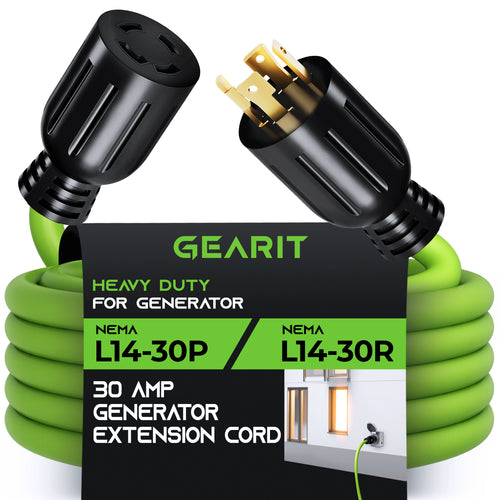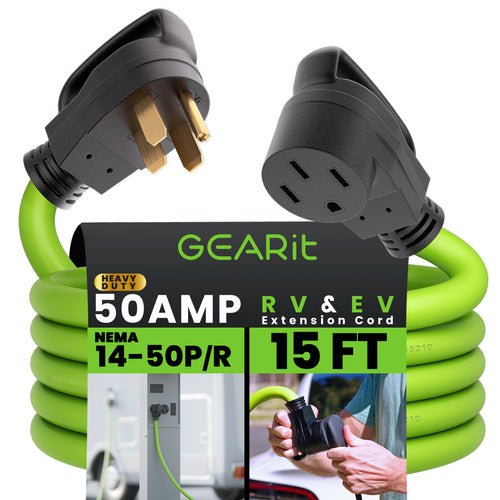Hitting the road in your RV can be the start of a great adventure for you and your family. You're ready to see new places and have new experiences. Before you leave, though, it's important to have all the gear you need, including the right power cords. As you shop, you may wonder about the differences between 30A and 50A RV power cord options and which is right for you. Here's your complete guide so you can make the right choice.
Understanding the 30A and 50A RV Power Cord
An RV power cord is a cable that connects the electrical system of the RV to an external power source, such as a campground electrical pedestal or a generator. This is critical for providing power to the various appliances in the vehicle that you'll need on your camping trip.
30A RV Power Cord
A 30A RV power cord is rated to carry up to 30 amps of current at 120 volts. This type of power cord is typically used in smaller RVs that have fewer appliances and electrical systems. It is also commonly found in older RVs that were built before 1990.
The 30A RV power cord is also relatively lightweight and easy to handle, making it a popular choice for RVers who value portability and ease of use. However, the 30A power cord has some limitations when it comes to powering larger RVs and more demanding electrical systems.
50A RV Power Cord
When comparing 30A and 50A RV power cords, the 50A is rated to carry up to 50 amps of current at 120/240 volts. It can be used in larger RVs that have more appliances and higher energy needs. This is also the type of cord you'll probably need for a newer RV.
The 50A RV power cord is heavier and bulkier than the 30A power cord, so you need to keep this in mind as you make your plans. However, a 50A cord is necessary for powering larger RVs.
Differences Between a 30A and 50A RV Power Cord
What are the differences you need to account for as you shop for a cord? Some people will try to use whichever cord they have the easiest access to, but several key factors make this less than ideal.
Power Capacity
The main difference between 30A and 50A RV power cords is the amount of electrical current they can carry. Since they are rated for different electrical currents, it's hard to switch one for another.
You could use an adapter to plug a 30A cord into an RV that calls for a 50A cord, but your camper still won't get more power than the 30A cord can carry. On the other hand, using an RV adapter to use a 50A cord on a 30A camper won't give you extra power, because the RV is only meant to handle certain loads.
Number of Circuits
You will also find that RVs will have different numbers of circuits depending on what type of cord is used. A camper running on a 30A RV cord usually has a maximum of five branch circuits, while an RV with a 50A cord can have more than five. This is important if you plan to add more appliances to your RV in the future. Without enough circuits available, you can't plug in an extra air conditioner or other items that draw a lot of energy.
Types of Appliances
Your power cord also matters as you shop for upgraded appliances for your RV. When looking at a 30A and 50A RV power cord, remember that 30A cords can't run 240V appliances. The voltages of those items are too high for the capacity of the cord. Depending on how your RV is set up, this could be a big deal or a minor inconvenience, since most RVs don't have many 240V outlets anyway.
Prong Configuration
Another difference between the two types of power cords is their prong configuration. The 30A power cord has three prongs arranged in an L-shape, while the 50A power cord has four prongs arranged in a two-by-two square. This difference in configurations ensures that the electrical current flows in the correct direction and that the RV is properly grounded.
If you have to switch to a cord that is not configured for your RV, you will need to bring an adapter. This can be a hassle and gives you less-than-ideal results for powering your camper, so it is better to invest in the right cord from the start to reduce the chances of problems.
Choosing the Right Cord for Your RV
Once you have decided between a 30A and 50A RV power cord, there are a few other factors that can narrow down your final choice:
- • Length: The power cord should be long enough to reach the electrical pedestal or generator, but not so long that it becomes hard to store. Consider the length of your RV and the location of the electrical hookup when choosing a power cord.
- • Durability: You want a power cord that is durable and can withstand the rigors of RV use. Look for a cord made of high-quality materials resistant to abrasion, heat, and weather. Gear It also offers a warranty on products so you can get help if something goes wrong.
- • Ease of handling and storage: The power cord should be easy to handle. Look for a cord that is flexible and easy to coil and uncoil. A carrying handle or storage bag can also be helpful.






















































